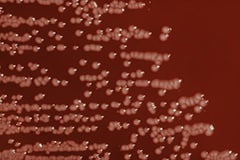Information for Health & Lab Professionals
Technical Information
Etiologic agent
Yersiniosis is caused by a facultative anaerobic gram-negative coccobacilli in the genus Yersinia (most commonly Yersinia enterocolitica serogroups O:3; O:5,27; O:8; and O:9).
Clinical features
Incubation period is typically 4–6 days (range, 1–14 days). Symptoms include fever, abdominal pain (may mimic appendicitis), and diarrhea (may be bloody and can persist for several weeks). Necrotizing enterocolitis has been described in infants. Reactive arthritis affecting the wrists, knees, and ankles can occur, usually 1 month after the initial diarrhea episode, resolving after 1–6 months. Erythema nodosum can also occur, manifesting as painful, raised red or purple lesions along the trunk and legs, usually resolving spontaneously within 1 month.
Diagnosis
Diagnosis is made by isolating the organism from stool, blood, bile, wound, throat swab, mesenteric lymph node, cerebrospinal fluid, or peritoneal fluid. If Yersinia infection is suspected, the clinical laboratory should be notified and instructed to culture on cefsulodin-irgasan-novobiocin (CIN) or other specific for growing it.
Treatment
Most infections are self-limited. Antibiotics should be given for severe cases. Y. enterocolitica isolates are usually susceptible to trimethoprim-sulfamethoxazole, aminoglycosides, third-generation cephalosporins, fluoroquinolones, and tetracyclines; they are typically resistant to first-generation cephalosporins and most penicillins. They are typically resistant to first-generation cephalosporins and most penicillins. Antimicrobial therapy has no effect on postinfectious sequelae.
Surveillance
The Centers for Disease Control and Prevention (CDC) monitors the frequency of Y. enterocolitica infections through the Foodborne Diseases Active Surveillance Network (FoodNet).
Incidence
Y. enterocolitica is a relatively infrequent cause of diarrhea and abdominal pain. Infection is more common in winter.
The incidence of yersiniosis in FoodNet sites in 2014 was 0.28 cases per 100,000 population. This met the U.S. Healthy People 2020 target for yersiniosisExternal
Take a look at recent trends in yersiniosis and other foodborne illnesses.
Transmission
Yersinia bacteria can be transmitted by consuming or handling contaminated food, most commonly raw or undercooked pork products; milk or milk products that were not pasteurized, inadequately pasteurized, or contaminated after pasteurization; or untreated water. They can also be transmitted by direct or indirect contact with animals.
Risk groups
Infection with Y. enterocolitica occurs most often in young children.

Colonial growth pattern displayed by Yersinia enterocolitica bacteria growing on a blood agar plate (BAP) medium.
CDC recommends the use of cefsulodin-irgasan-novobiocin (CIN) agar for isolation of Yersinia spp. from nonsterile sites.
Incubation at 25° C is recommended to prevent loss of the virulence plasmid in Y. enterocolitica. In addition, the lower temperature favors the growth of Yersinia over some other members of the Enterobacteriaceae family that can grow on CIN agar.
Biochemical or molecular tests should be performed on a pure culture for complete identification.